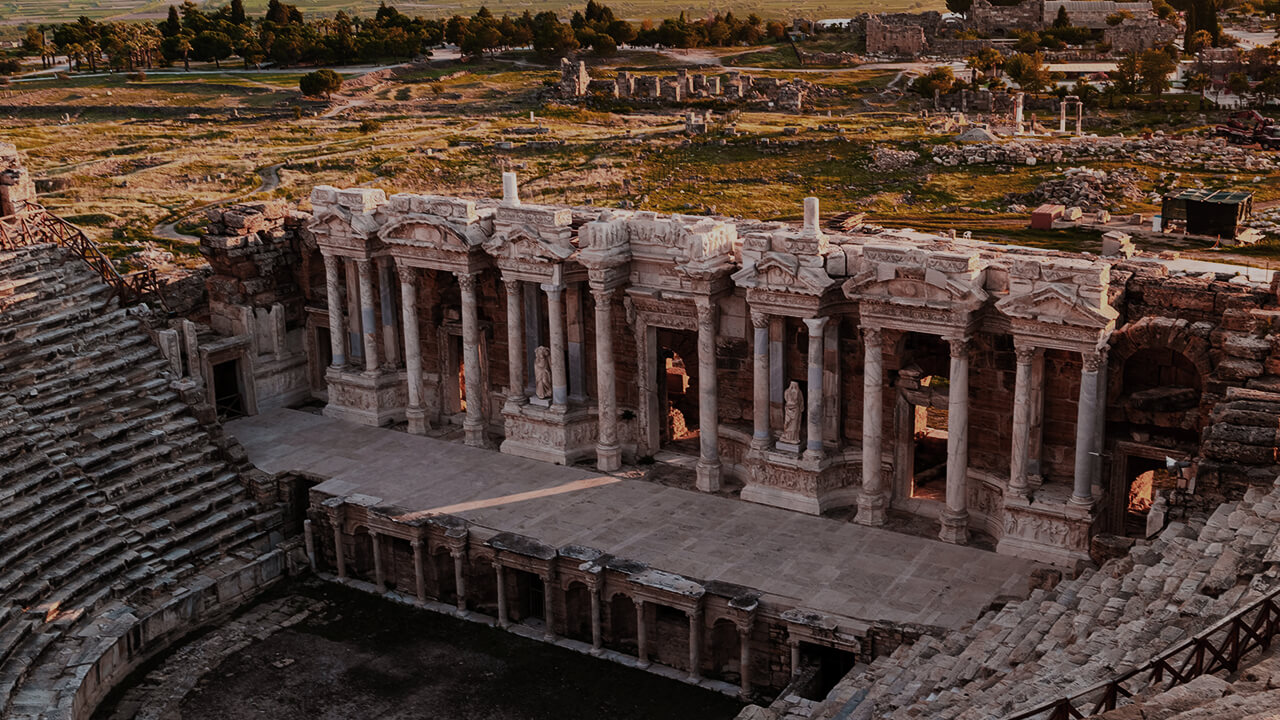
10.03.2023
5 Dakika
Nature, which has taken the role of an artist in Türkiye, has created unique beauties. One of these beauties are the travertines of Pamukkale, which almost everyone who wants to visit Türkiye has met in one way or another. The 200-meter high travertines, formed by contact with high mineral water flowing into the Çürüksu Plain and resembling a fantastic bath created by nature, are on the list of places that many travelers must see.
The Hierapolis, which is located right next to the travertines of Pamukkale, proves that this area was appreciated by people not only today but also thousands of years ago. The Hierapolis Ancient City, which is a cultural value that people added to the travertines of Pamukkale thousands of years ago, where nature shows its artistic face, proves that it is a unique part of the common heritage of humankind with its inclusion in the UNESCO World Heritage List. Let's get to know a little more about this fascinating ancient city.
Hierapolis was founded in the 2nd century BC by the Attalid dynasty, which ruled the kingdom of Pergamon, and served as a thermal resort. The thermal springs near the city, which at the same time were also used for washing and drying wool, were distributed throughout the region by taking advantage of the natural features of the terrain and building complex water transport systems. After being destroyed by an earthquake in 60 AD, Hierapolis was rebuilt by the Roman Empire. The buildings that are preserved in the ancient city date from this period.
Hierapolis, a center of healing associated with religious practices, became a frequent destination for ancient people seeking a cure for their health problems. The 3 ancient baths, whose ruins still exist today, are the structures that have survived to this day from this part of the city. One of these structures, the Great Bath, is now used as an archaeological museum.
The theater, one of the most magnificent structures of the archaeological site of Hierapolis, is also a work worth seeing. The theater, which bears in its ornaments the traces of the Pergamon school of art, is a building worth seeing, very well preserved.
Besides the baths and the theater, Hierapolis also has a sanctuary called Ploutonion, dedicated to the god Pluto. It was built over a cave from which toxic gasses were emitted due to the thermal activity in the region. It was believed to be connected to the land of the dead under the rule of Pluto. In the following years, the Temple of Apollo was built on this sanctuary, the ruins of which can still be seen today.

Hierapolis, which was considered a holy place according to Roman and pre-Roman pagan beliefs, was also considered sacred by the early Christians and became a religious center. The fact that Saint Philip, one of the 12 apostles of Jesus Christ, was killed here and the Martyrium where the saint's tomb is located lead to the city being considered holy by Christians. The Martyrdom of St. Philip, located outside the northwestern walls of the ancient city, where there is also an early Christian cathedral, a baptismal font and the Church of the Pole, is a structure worth seeing.
The wide main street of Hierapolis with its porticoes on both sides, important public buildings and monumental gates at the ends is also a very suitable place for those who want to get an idea of life in the city hundreds of years ago. The monumental gates in the shape of a triumphal arch at the ends of the main street offer the first view of the ancient healing center. Also in the necropolises around the city, which contain more than 2000 tombs, you can see the traces left in the world by the people who came and went hundreds of years ago.
The ancient city of Hierapolis is located next to the travertines of Pamukkale, one of the natural wonders worth seeing, and is both a sanctuary where you can trace the layers of religious change over thousands of years and a place where you can discover the traces of an ancient medical tradition interwoven with this area. When you visit Hierapolis, you can stay in establishments near the ancient city and the travertines, where you can take advantage of the thermal springs that are still considered a source of healing and add a healthy rest to your cultural gain.